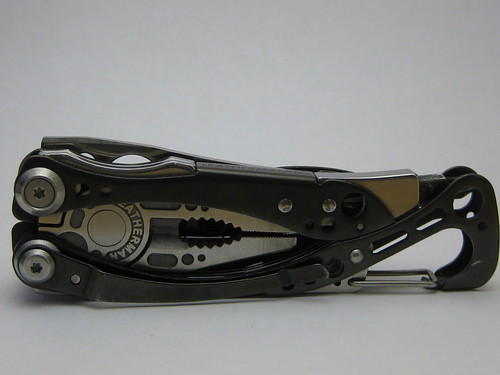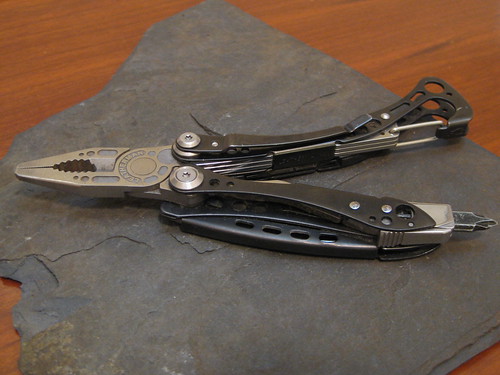Leatherman Skeletool CX Review
The Leatherman Skeletool is really the first 3rd generation tool designed by Leatherman. The PST served as the template for pretty much every tool they made for a while and still some tools today (such as the Super Tool). Then the Wave and Charge came along with their huge compliment of tools and outside accessible knife blades. But it was the Skeletool with this highly refined and unusual design that pushed Leatherman into a new generation. Seemingly every idea about multitools was re-examined during the design phase of the Skeletool. It was no longer roughly symmetrical. It was no longer crammed full of tools. And all of the tools, except the pliers, were externally accessible. It was a total rethink and it paid off in spades. There is no other multitool, in my opinion, that really works as an EDC. Most are either too big, like the Charge and Wave, or too small like the Squirt and Mirca. They all have their roles, but the Skeletool is the ideal lightweight EDC.
There are two models: the Skeletool and the Skeletool CX. The CX has carbon fiber scales, while the other version has steel pieces in their place. The carbon fiber is purely decorative as it saves nothing on weight. The CX version has a better blade steel, 154CM v. 420HC, than then regular model, making the upgrade worthwhile. My version is the original run of the CX and it has a partially serrated blade. The newer version has a straight edge. Here is a review of the tool. Here is a video review. Here are the Amazon reviews with 4.37 stars out of 5 with 371 (!) reviews. Here is my Skeletool CX (which I have had for four years now, I got it the year it was released):
Design: 2
I imagine that the design of the Skeletool was a painstaking process. So much of the tool is completely new and completely different from previous Leatherman offerings that it looks as though they threw away the old design book entirely. The jump from PST first gen to Wave/Charge second gen tools was evolutionary. That is, there were echoes of PST all through out the Wave and Charge, but here there is virtually nothing the same from the PST to the Skeletool except for the one signature Leatherman trait: the balisong style pliers.
All these design changes were worth it. The tool is both significantly lighter and better performing than the PST (which I still have; I lost it and found it again after 10-12 years only last year...it is in great shape). It comes in at a staggeringly light 5 ounces and everything just works well. Even years later I am discovering new touches that make things better. The carabiner clip is tremendously useful as you can clip it everywhere AND clip it to something with any tool open for immediate access and use (though I don't recommend doing that with the knife open). Even the pivot on the knife is well designed. The oversized pivot screw is smooth but it also acts as a reverse Hinderer style lock bar stop (because the liner extends outward, the pivot prevents it from going past the tang of the blade). See below:
I imagine that the design of the Skeletool was a painstaking process. So much of the tool is completely new and completely different from previous Leatherman offerings that it looks as though they threw away the old design book entirely. The jump from PST first gen to Wave/Charge second gen tools was evolutionary. That is, there were echoes of PST all through out the Wave and Charge, but here there is virtually nothing the same from the PST to the Skeletool except for the one signature Leatherman trait: the balisong style pliers.
All these design changes were worth it. The tool is both significantly lighter and better performing than the PST (which I still have; I lost it and found it again after 10-12 years only last year...it is in great shape). It comes in at a staggeringly light 5 ounces and everything just works well. Even years later I am discovering new touches that make things better. The carabiner clip is tremendously useful as you can clip it everywhere AND clip it to something with any tool open for immediate access and use (though I don't recommend doing that with the knife open). Even the pivot on the knife is well designed. The oversized pivot screw is smooth but it also acts as a reverse Hinderer style lock bar stop (because the liner extends outward, the pivot prevents it from going past the tang of the blade). See below:
All in all, very, very impressive design. Sometimes I wonder why I carry a knife at all when I have this guy sitting in a drawer. The truth is if I am doing any kind of maintenance or woodworking I usually do carry this instead of a knife. Pliers are just too helpful.
Fit and Finish: 2
After quite a few years of use, this guy still looks nice and works well. The 2D bits have finish coming off of them, but other than that nothing shows any significant signs of wear and tear. All of the edges of the tool are immaculately finished, rounded off where needed.
Purpose: 2
The pared down offerings and the size and weight of the Skeletool make it obvious--this is an EDC multitool and it accomplishes this task very well. All of the tools are generally and broadly useful. There is nothing like the ridiculous SAK corkscrew or as silly and useless as both a diamond coated file and a wood/metal file on the Charge. A perfect example of a good, coherent, and unified purpose that influenced each and every design decision. Excellent job.
Grip: 2
The Victorinox Spirit's bowed handles predate the Skeletool and they showed people that straight handles on a pair of pliers does not work well. I love the grip of the tool in plier mode:
I also think it works quite well in knife mode. Even the screwdriver mode is easy on the hands (and you can use it as a half-T driver if you need a little extra torque.
Carry: 2
So if I was comparing this to the cloaking device like carry of a Sebenza Small it would not get a 2. In fact the clump, bulky weight at the top of the tool when closed and hooked to your pocket would probably scale as a 0. But this isn't a knife. When compared to multitools it is quite impressive. It doesn't disappear by any means, but trying to carry a PST or a Wave out of their sheath and without an accessory pocket clip is a real chore they are just big, heavy, and boxy. They feel like a sock full of nickels hanging around and banging around at the bottom of your pocket. The Skeletool doesn't. It approaches the quiet carry of a knife but still includes a hearty set of pliers. The only other knock I have is that the pocket clip is not on a center line through the tool which sometimes caused the tool to wrap itself around your pocket. This is very infrequent and probably inherent in all multitools with a pocket clip, so again no knock, but still something to note.
Materials: 2
154CM steel, especially this blend, is really nice. The pliers feel substantial and don't twist. The handles are very stable even if they flex a little under a very substantial amount of force. Everything is more than above par for a multitool. Only the Charge, with its S30V blade steel, has clearly superior materials and even then I am not sure how much better S30V is over 154CM.
Deployment/Accessibility: 2
Everything is externally accessible except for the obvious--the pliers. I also like the fact that there is no "tool clump" like on most multitools (I mean a bunch of tools that share a pivot and tend to come out together). All of the tools are essentially separate from each other making them easier to use and easier to access. The carabiner also makes it nice to store the tool in an open position, as mentioned above. This is especially handy when using the screwdriver.
Retention Method: 2
There are two retention methods, the pocket clip and the carabiner. The carabiner works very, very well. The pocket clip works about as well as you could expect given that it is on a multitool. The combination of the two however make this a really easy tool to keep on or around you during work.
Tool Selection: 2
In the arms race of multitools the number of individual tool functions crammed on to the frame of the tool itself became insane. Dozens of individual little pits of metal some of which had questionable utility beyond adding to the tool count were the norm, even with Leatherman. "18 Tools!" then "21 Tools!" and on and on. But the Skeletool's revolutionary design is based in large part on the fact that it opted out of this silly competition in favor of a small handful of well-designed tools (1. Pliers, 2. Knife, 3. Phillips, 4. Flathead, 5. Wire cutter, 6. HARD wire cutter, and 7. Bottle opener). The selection is, in my opinion, perfect. In other words if someone said you get only seven tools it would be the seven they included. Those are the seven I use the most on other multitools. I have used all of them on the Skeletool many times. In order of utility, they are all roughly equal, a sign of a good selection. If I were add one more it would be a pair of scissors or the new clam shell cutter on the new Leatherman Wingman (which is marvelous looking tool in its own right). But if I only had seven, it would be these seven.
Tool Performance: 1
Everything about each of the seven tools is very well done with one GLARING exception. I like the knife's size and shape. I like the angle of the bottle opener. I even like the 2D bits and their chosen sizes. The wire cutters work well. It seems like it should be a no-brainer, right? But the pliers are too blunt. They seem to be significantly more blunt than the pliers on any other multitool Leatherman makes. This bulky shape makes detail work, an important function of pliers, very difficult with the Skeletool and has been a real impediment to work I was doing more than once. The hollow interior portion of the tool seems to have ample space for a longer and thinner pair of plier jaws, but instead we get this rounded off mess. It is such a big deal that I considered giving the Skeletool a 0 in this criteria, but after much deliberation, I decided to give it a 1 in recognition of the truly superior knife blade, carabiner, and screwdriver bits. Still, this is an unforgivable mistake.
Overall Score:19 out of 20




